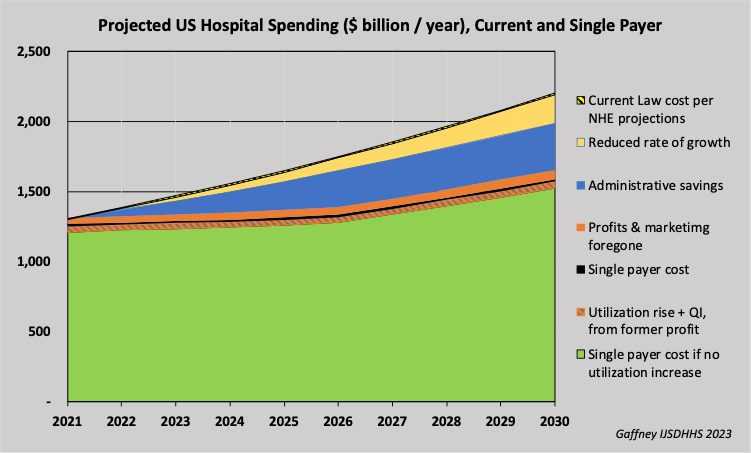Projected Savings from Hospital Global Budgets under Single Payer
February 7, 2023
Summary: A new study quantifies huge anticipated gains over 10 years – $2.5 trillion in financial savings alongside added resources for clinical care – by shifting hospital financing from today’s service-based payment and profit generation to global budgeting.
Hospital Expenditures Under Global Budgeting and Single-Payer Financing: An Economic Analysis, 2021–2030
International Journal of Social Determinants of Health and Health Services
February 2023
By Adam W. Gaffney, David U. Himmelstein, Steffie Woolhandler, & James G. Kahn
Abstract
U.S. hospitals provide large amounts of low-value care and devote inordinate resources to administration, while some hospitals leverage market power to realize large profits. Meanwhile, many rural and safety net hospitals are financially distressed. The coexistence of waste and want suggests that U.S. hospital financing is neither efficient nor equitable.
We model the economic consequences of adopting the mode of hospital payment used in Canada and the U.S. Veterans Health Administration and proposed in the leading congressional single-payer Medicare-for-All bill: global budgeting. Our models assume increased utilization due to expanded and upgraded coverage; gradual reductions in administrative costs from simplified payment; and the elimination of hospital profits, with hospital capital expenditures funded by explicit grants rather than from profits or borrowing.
We estimate that non-federal hospital operating budgets will total $17.2 trillion between 2021 and 2030 under current law versus $14.7 trillion [14.5% lower] under single-payer with global budgeting. This difference of $2.5 trillion reflects $520 billion in foregone profits and $1,984 billion in reduced expenditures on hospital administration. Expenditures on clinical operating budgets, however, would be higher than under current law, funded out of profits.

Comment by: Jim Kahn
This economic analysis (full disclosure: HJM authors, including myself) quantifies the anticipated changes in hospital costs over 10 years with a shift to global budgeting. The cumulative savings are estimated at $2.5 trillion, nearly 15% of the total.
The chart conveys the key findings: Savings accrue most of all by simplifying administration, but also by eliminating profit and slowing the rate of growth. At year 10, when current law spending is projected at $2.2 trillion, single payer is $1.8 trillion. These analyses include an allowance for increased care and quality improvement. Global budgets would assure financial stability, protecting hospitals for rural areas and when medical care needs shift.
This funding mechanism echoes the approach used successfully in most other wealthy countries. And the hospital analysis illustrates the kinds of savings that single payer would offer across the health system.
Global budgeting of hospitals (and of the entire health system) would require a complete shift in how we pay for medical care. That’s what’s needed. Single payer, putting patients above profits.
You might also be interested in...
Recent and Related Posts
Political Party Split vs Concurrence on Government Guarantee of Health Care
Cross-National Insurance Contrasts in Amusing 1-minute Videos
